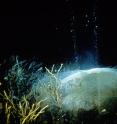Here is the oil in the gulf? FSU researcher takes a look
A Florida State University researcher and his team have developed a comprehensive analysis of oil in the Gulf of Mexico and determined how much of it occurs naturally and how much came from the 2010 Deepwater Horizon spill. And more importantly, their data creates a map, showing where the active natural oil seeps are located.
The research was recently released online by the Journal of Geophysical Research Oceans and is also the basis for a paper with researchers at Columbia University published today in Nature Geoscience.
In total, 4.3 million barrels were released into the Gulf from the oil spill versus an annual release of 160,000 to 600,000 barrels per year from naturally occurring seeps, according to the new results.
"This information gives us context for the Deepwater Horizon spill," said FSU Professor of Oceanography Ian MacDonald. "Although natural seeps are significant over time, the spill was vastly more concentrated in time and space, which is why its impact was so severe."
Among the findings was that dispersants were able to eliminate about 21 percent the oil that floated on the surface of the Gulf of Mexico after the spill, but at the cost of spreading the remaining oil over a 49 percent larger area.
This map of oil also provides a basis for additional scientific research.
Using this new set of data, scientists will be able to go to a controlled area where they already know oil exists and perform controlled observations, as opposed to spilling new oil into an area. It also shows how the Gulf has adapted to natural oil seeps.
Researcher Ajit Subramaniam, an oceanographer at Columbia University's Lamont-Doherty Earth Observatory, used the data set to focus on natural oil seeps and discovered something unusual -- phytoplankton, the base of the marine food chain -- were thriving in the area of these natural oil seeps. The results published in Nature Geoscience show that phytoplankton concentrations near the oil seeps were as much as twice as productive as those a few kilometers away where there were no seeps.
"This is the beginning of evidence that some microbes in the Gulf may be preconditioned to survive with oil, at least at lower concentrations," Subramaniam said. "In this case, we clearly see these phytoplankton are not negatively affected at low concentrations of oil, and there is an accompanying process that helps them thrive. This does not mean that exposure to oil at all concentrations for prolonged lengths of time is good for phytoplankton."
MacDonald had been working on data using satellite images of natural oil seeps for 10 years, and added in the Deepwater Horizon spill work a few years ago.
"It's giving us a basis for all of these other experiments," MacDonald said. "It's really revolutionizing how we look at the Gulf. It also gives scientists the exact geographic points where oil from the spill was located, so researchers can go to the Gulf floor and explore the area to see if there has been any environmental effect."
Source: Florida State University
Articles on the same topic
- In Gulf Of Mexico, microbes thrive above natural oil seepsMon, 25 Jan 2016, 20:23:43 UTC
